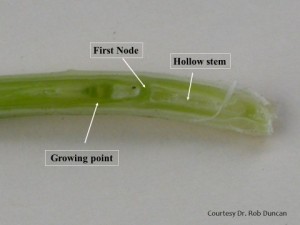by Dr. Calvin Trostle, Extension Agronomy, Lubbock, 806-746-6101, ctrostle@ag.tamu.edu;
Dr. Clark Neely, Extension State Small Grains Specialist, College Station, 979-862-1412, cbn108@tamu.edu
AgriLife Extension staff across Texas often observe a common misunderstanding about N fertilizer/N topdress timing and wheat grain production. Many producers don’t realize the critical timing of topdress N on wheat—and are often not applying topdress N soon enough if they are going to grain. Thus they are losing yield potential.
In other winter wheat production regions of the U.S., farmers usually think of Spring topdressing, but in Texas—even in the Panhandle—we should view N application as ‘Late Winter’ topdressing. To some, Spring means calendar March 21, but that is late for almost all Texas wheat.
Properly timed topdress N for wheat is tied to a critical growth stage. What you visually see in the field is ‘jointing,’ that is, you begin to notice a few stems here and there coupled with erect growth. If you rub the lower stem between your thumb and forefinger you may feel a small ‘bee-bee,’ or node, within the stem. This means the growing point for that individual stem is differentiating, i.e., the growing point has switched over from producing another leaf to now determining potential head size (spikelet number, potential seeds per spikelet, Fig. 1). This is an important component of yield potential. Because this process for an individual head only lasts about 7 to 10 days, when you see the first few joints then most of the rest of the field has probably initiated growing point differentiation.

Figure 1. Sliced wheat stem reveals young growing point differentiation with hollow stem to the right. Growing point differentiation—spikelet number and seeds per spikelet—is likely complete. (Photo courtesy Dr. Rob Duncan.)
To ensure that developing grain yield potential is not limited at this point, sufficient N must not only be “on the field,” but it also must be in the root zone as a result of rain, melting snow, or irrigation. Until this happens wheat might experience inadequate N resources to drive yield potential higher. (If you grow irrigated wheat, ensuring growing conditions have adequate moisture is likewise important for yield.) Current recommendations suggest applying 1/3 of N requirement in the fall followed by 2/3 applied at topdress.
The full guide for N topdressing with the above title, developed for the Texas High Plains, is also directly applicable for the Rolling Plains and Concho Valley. “Nitrogen and Wheat Grain Production—Topdress N Timing is Critical,” contains two sections relating to N topdressing for wheat grain:
• The growth stages of growing point differentiation and jointing (Feekes 5.0) are described and why they are important;
• Using a question-and-answer format (subtitled ‘Sixteen Questions about N for Wheat Grain, Texas High Plains), we explain different aspects of topdressing N on wheat and how producers can determine the target amount of N application, manage the timing, deal with exceptions including weather factors, etc. Example questions among the sixteen discussed include:
#1) What is the general N requirement for wheat grain production?
#5) Is there any benefit for N applied after jointing? What if I am late applying my N, should I still do it?
#8) There is a good chance of rain or snow in the forecast. Should I go ahead and apply my topdress N a few weeks earlier than otherwise expected?
For a copy of the High Plains report on topdressing N in wheat, consult the full edition of this document at http://lubbock.tamu.edu for the link entitled “Nitrogen Topdress for Wheat—Sixteen Questions.” Principles of this report are applicable to South, Central, and Northeast Texas as well, though timing will move forward on the calendar to match wheat growth stage. In most years, the majority of South and Central Texas should consider topdress timing beginning in late January and into February. This past fall was quite wet which delayed planting of many wheat fields into December and in a few cases even into January. In these cases, jointing likely will not occur until later in February and thus topdress can also be delayed as well.

Calvin Trostle
Professor and Extension Specialist
Lubbock, TX
803.746.6101
ctrostle@ag.tamu.edu